Article by April Dell // Sept. 27, 2018
Imagine the artist as a messenger. They transmit, decode, untangle and entangle the data feed of the everyday through familiar and unfamiliar means. ‘Strange Messengers’, the current group show at Peres Projects, presents the work of seven artists who in one way or another navigate the conditions of contemporary life. Ever-evolving political, social and environmental concerns spread anxiety, cynicism and fatigue. The messengers ask and give obscured answers to the question: how do we exist and take care of ourselves in this vulnerable and fraught terrain? The objects that fill the austere gallery space are their messages and these objects have absorbed the conditions of their creation, bear traces of their surroundings, and project our image back to us. They unveil, disguise, perform and survive.
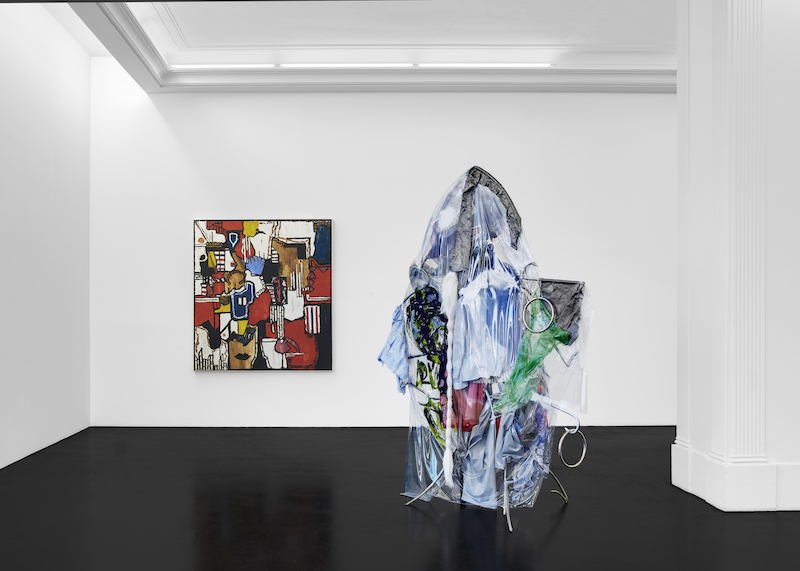
Group show: ‘Strange Messengers,’ Peres Projects, Berlin, 2018 // Photo by Matthias Kolb, Courtesy of Peres Projects
An abstract oil painting by Dorothy Iannone from 1964 is positioned as the point of departure for ‘Strange Messengers’; Iannone herself a bold and unapologetic messenger of feminism and sex-positivity. At one end of the long rectangular gallery space, the characteristically loud painting presides authoritatively over the show, setting the tone with a history of identity politics, censorship and intimately personal stories. Sharing the colours and complex compositions of the erotic figurative works that define her career, this painting gives us a small glimmer of the unabashed sexuality of her later subjects; a coy smile on a pair of black lips.
Suspended opposite Iannone’s Dark Lips, and mirroring the suggested representation of the body, is Sumac Quilla a sculpture by Donna Huanca. Layers of clothing, textiles, paint, plastic and steel build up a hovering form like a hulking ghost, a featureless composite figure made from the shedded layers of others. Skin is a recurring motif in Huanca’s practice, often coated in layers of paint, whether printed on canvas or on the bodies of her performers. Here, the clothing, painted textiles and sagging sheets of plastic act as skins. They are the layers that wear our identity and project it to the world, as well as the layers onto which the world projects back at us.
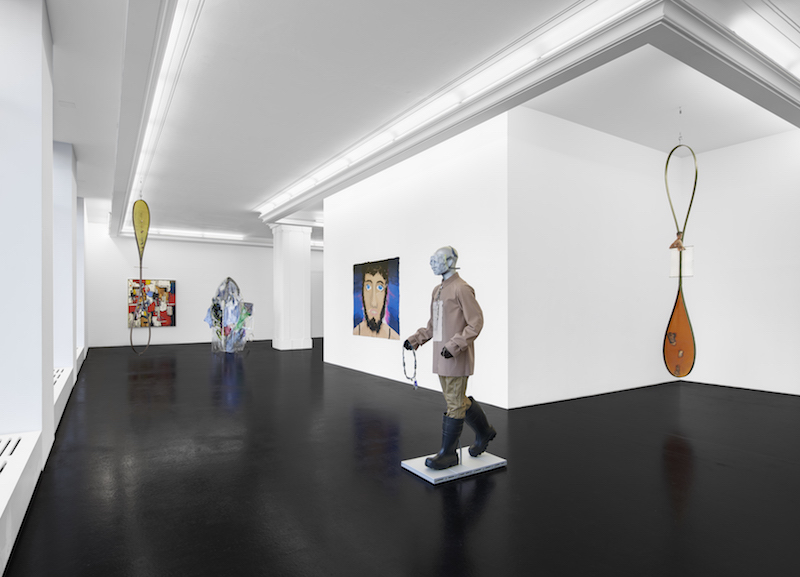
Group show: ‘Strange Messengers,’ Peres Projects, Berlin, 2018 // Photo by Matthias Kolb, Courtesy of Peres Projects
Dominating much of the gallery space are several sculptural works by Jack O’Brien, hanging like giant pieces of handmade jewellery or decorative mobiles. Their aluminum frames are adorned with silicone beaded threads like ornate trimmings or else like magnified dangling sticky silk traps. Magazine cutouts of the faces, facial hair and bodies of beautiful men are caught in the beaded webs. The soft gaze of the faces and the curved contours of the cutouts display a subtle eroticism. One can think of O’Brien as a collector of desirable forms, giving us a tiny taste but withholding the full picture. Ok my words and made a trap arranges the forms on a beaded grid, where Shed me for telling you traps torsos in amber like specimens. Removed from their context by the artist’s scissors, the body parts are made into objects, censored and sexualised at the same time. Like we do when we flick through magazines, the works process and catalogue these body objects, scrapbooking the pieces with our memories, desires and self-image.
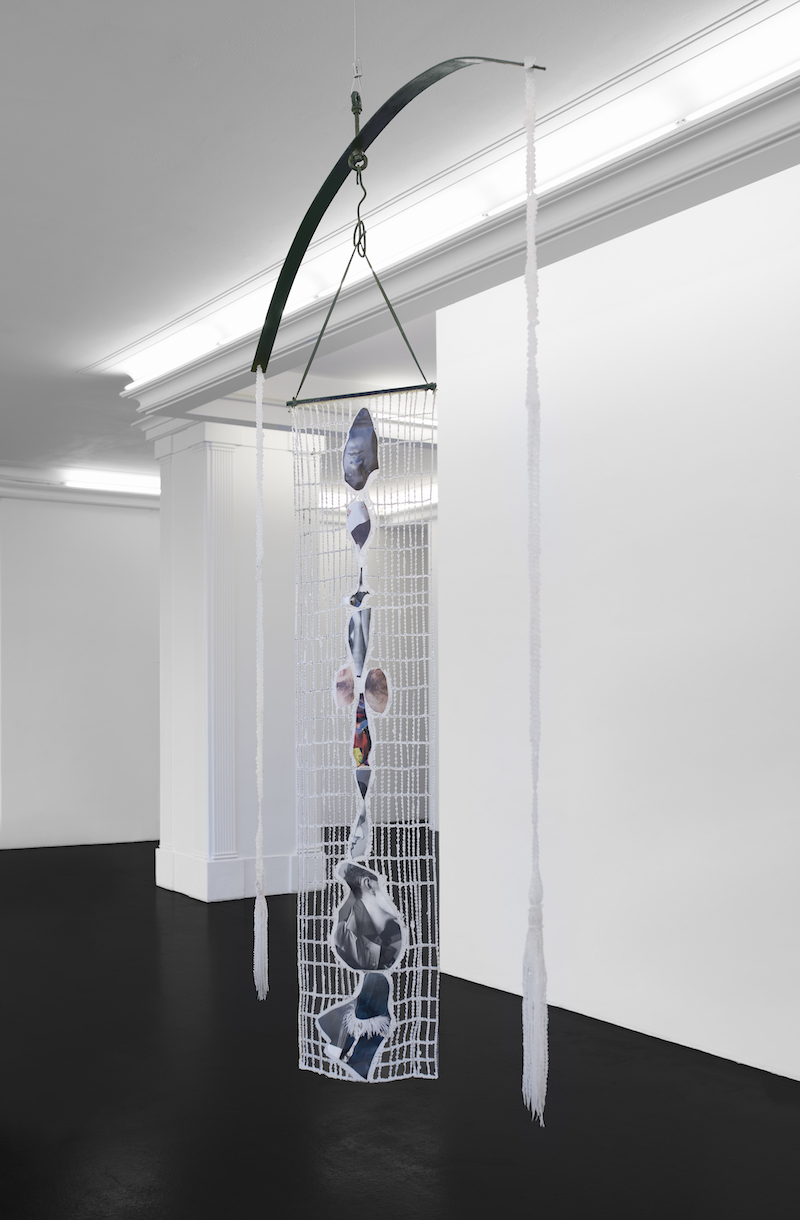
Jack O’Brien: ‘Ok my words and made a trap,’ 2018, Silicone, Latex, Aluminium, Cloth, Paper, Steel, Dust. 260x184x38cm // Photo by Matthias Kolb, Courtesy of Peres Projects
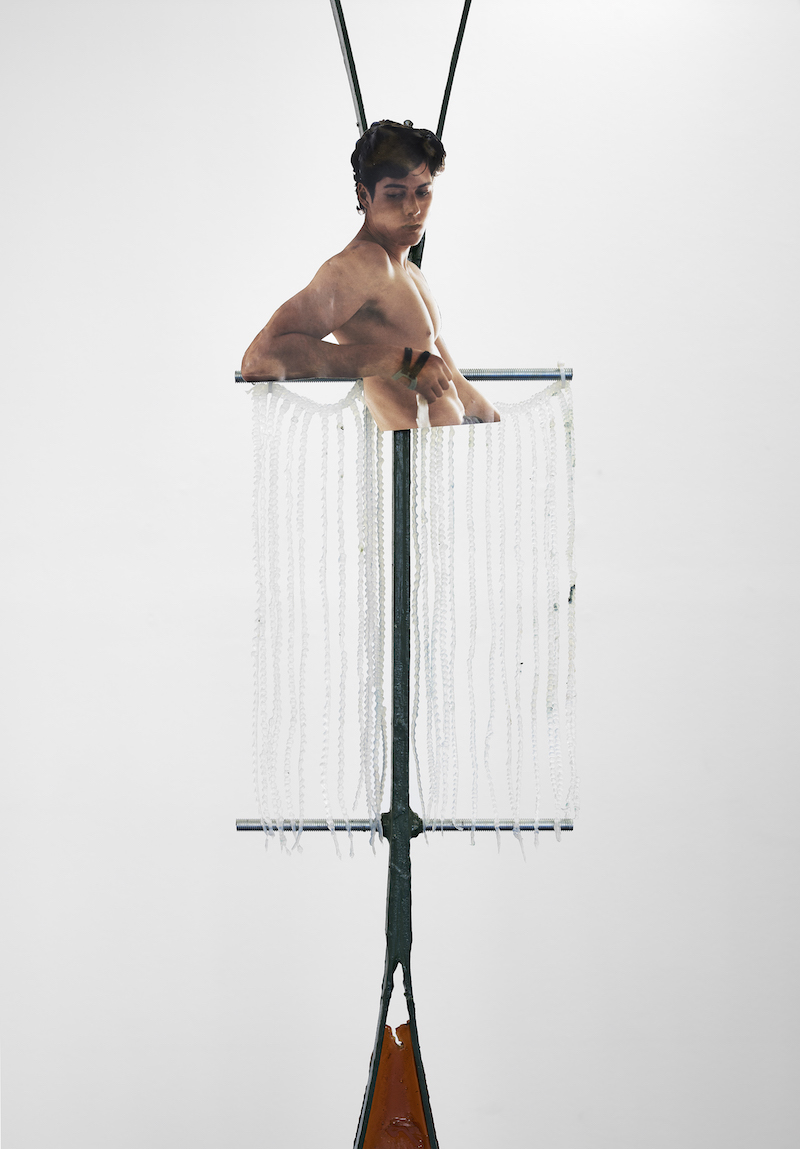
Jack O’Brien: ‘Shed me for telling you,’ 2018, installation detail, Latex, Aluminium, Cloth, Paper, Steel, 331x40x6cm // Photo by Matthias Kolb, Courtesy of Peres Projects
Steffen Bunte’s figurative sculptures reflect a different kind of self-image, digitised, seamless yet not uncomplicated. His are composite figures that merge the human experience of a digital world with the technology that drives it. Bunte’s recurrent use of automotive parts and industrial materials appears here in Heute (seated) with neatly upholstered surfaces in faux leather and bright untarnished aluminum. The mannequin seated upon this industrial bed-like platform looks out from behind a warped PET mask and wears customised athletic workwear. “CLEAR WATERS” is printed on the shirt like a brand or company logo, the environmental message of which is in almost satirical contradiction to the industrial production the work embodies. A few personal and organic items adorning the sculptural figures, as well as the disturbingly expressive forms of the masks, maintain a human presence in Bunte’s works and resist a neatly represented and unemotional view of the digital future.
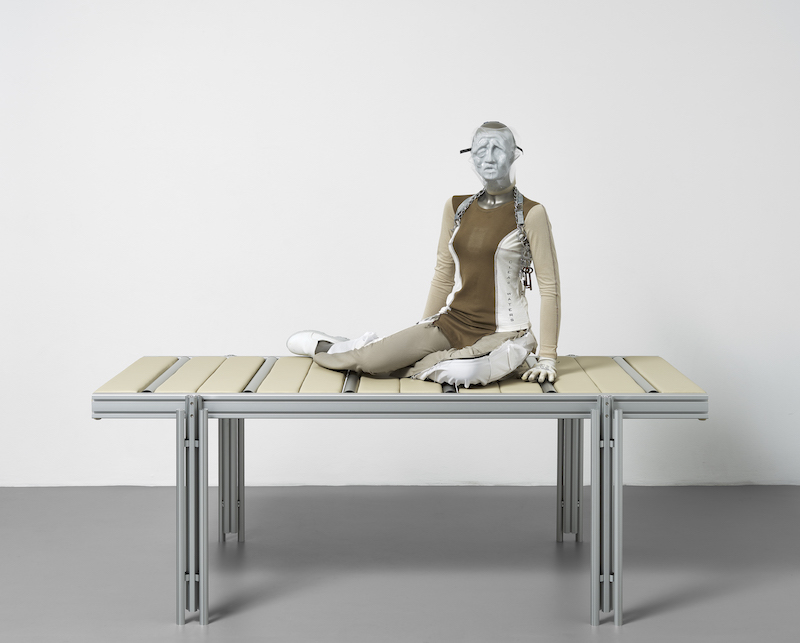
Steffen Bunte: ‘Heute (seated),’ 2018, Sculpture, 166x202x101cm // Photo by Matthias Kolb, Courtesy of Peres Projects
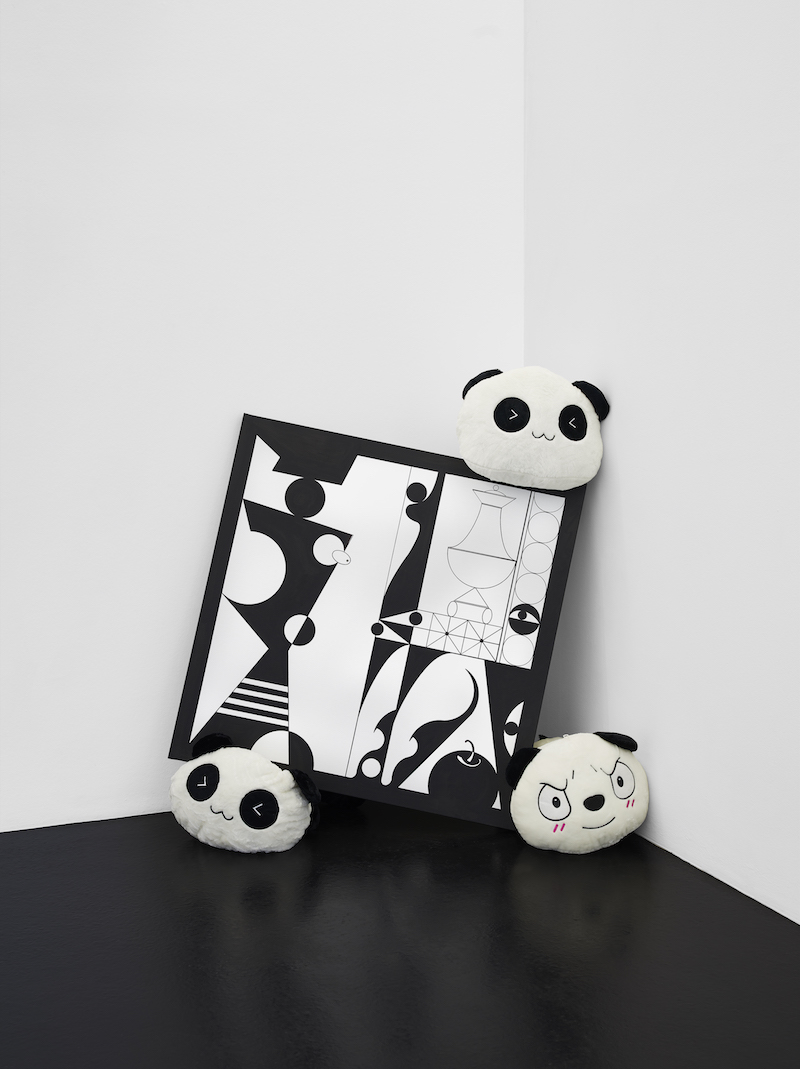
Ad Minoliti: ‘Queer Modular -Panda-,’ 2018, installation view // Photo by Matthias Kolb, Courtesy of Peres Projects
Awkwardly propped in the corner between three anime-style panda stuffed toys, is a painting by Ad Minoliti. The forms are flattened, monochromatic, modernist. In the context of her wider practice that often references and subverts modernist art, design and architecture, Queer Modular -Panda-could be understood as destabilising the dominant order; a queering of modernist rationale. In her work, Minoliti foregrounds and rewrites the binary between the masculinity of modernism and femininity of organic or chaotic forms. The jaunty and disorderly display of the painting breaks the facade of what we expect to be the normal state of affairs and asks us to reconcile with our expectations of “normal” and “abnormal.” Also subverting architectural forms is Rebecca Ackroyd whose recreations of shuttered shop fronts from her home in London bring the outside inside and make the public personal.
At the other end of the room, the huge bright wall-hung canvas by Manuel Solano is subverting gender binaries with explicit intent. Solano, who draws much of their imagery from pop culture, has recreated the cover art of Peaches’ 2003 album Fatherfucker that portraits the musician with a beard. The gender inversion of the album title itself is a strong example of the gender boundaries Peaches subverts in her unblushing and unabashed persona and lyrics. That With a Beard is composed by memory and painted directly on the canvas with the blind artist’s hands declares it a meaningful and potent image that has stuck in Solano’s mind. Of all the works in the show, this one speaks the most loudly and directly about the freedom of identity expression. It suggests that concepts of gender diversity have come a long way since 2003, while maintaining the reality that the work for mainstream acceptance is still a hurdle to overcome.
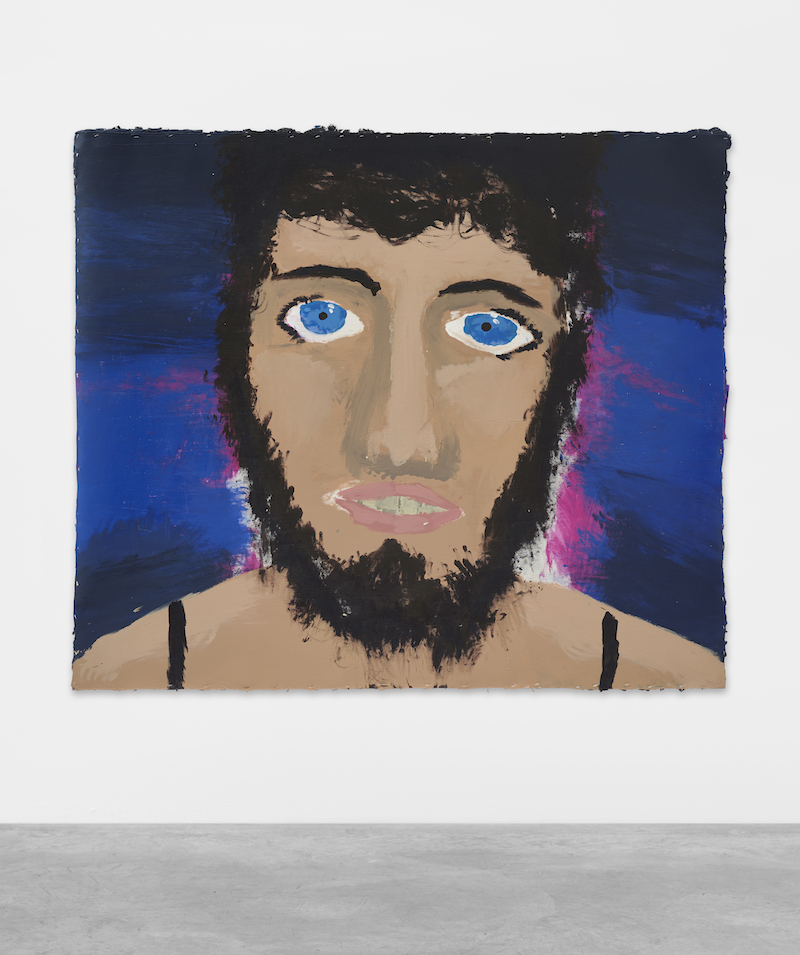
Manuel Solano: ‘With a Beard,’ 2018, Acrylic on canvas 154x180cm // Photo by Matthias Kolb, Courtesy of Peres Projects
The varying mediums and points of cultural or personal reference in the show culminate in an intersecting network of messages. They process the exterior and internalised social and material forces upon the bodies represented by or physically absent in the works, some to clear conclusions and others not. In this sense, bodies are everywhere in the show, only sometimes figuratively, but always present. The artists’ bodies, symbolic imagined bodies, social or political bodies, are at the center of this group of works. Sharing with us their cryptic messages of self-care and survival, they peer from behind the familiar forms and materials of our contemporary lives, like Iannone’s smiling dark lips.
This article is part of our monthly topic of ‘Care’. To read more from this topic, click here.
Exhibition Info
PERES PROJECTS
Group Show: ‘Strange Messengers’
Exhibition: Sep. 14 – Oct. 26, 2018
Karl-Marx-Allee 82, 10243 Berlin, click here for map
Writer Info
April Dell is a freelance writer living and working in Berlin.





















